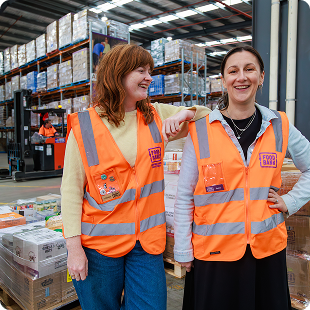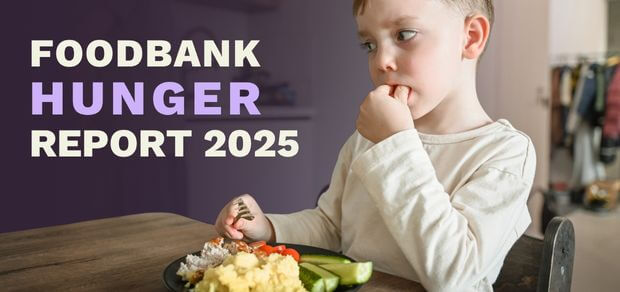Our two cents on the Victorian Food Security Inquiry — read the response here
Foodbank Victoria has submitted a response to the Victorian Parliamentary Inquiry into Food Security, reflecting on key themes and areas of opportunity raised in the report.
Foodbank Victoria’s response to the Legal and Social Issues Committee (LSC) of the Victorian Legislative Council report: Food Security in Victoria, released Thursday 14th November 2024 following the Inquiry into Food Security in Victoria.
About Foodbank Victoria
Foodbank Victoria has been providing vital food relief to Victorians for 95 years. Our dynamic and responsive model has shifted over time as we respond to the changing needs of the Victorian community.
We deliver food to people who need it in three different ways: in partnership with our charity partners, through schools and via our regional Community Food Centres, and we maintain strong relationships with all our partners to ensure our work is responsive. Across our network of 473 charity partners, 1173 schools and the two regional Community Food Centres, we have distributed over 25 million meals in the last 12 months, which provides approximately 75% of the food into the statewide Food Relief Sector, and we currently feed 69,000 Victorians a day. Social supermarkets, cooking classes and a social cafe run in our two purpose-built Community Food Centres in Ballarat and Morwell. As the state’s dedicated emergency food relief organisation, we also assist Victorians through natural disasters and pandemics. Foodbank Australia recently undertook external research examining their Social Return on Investment and determined that for every dollar invested, $5.83 of social, economic and environmental value is expected.
LSC report: Food Security in Victoria
Foodbank Victoria commends the LSC on a comprehensive report and set of 25 recommendations looking at short- and long-term activities and solutions to food insecurity in Victoria. Foodbank Victoria recognises three key themes centred around schools, healthy food relief and data-driven decision making from this report that should be areas of focus for the Government to drive change in food insecurity across Victoria.
Schools
In partnership with the Victorian Government, we deliver Australia’s largest School Breakfast Clubs Program (SBCP) to primary and secondary state schools across Victoria and will expand to all Victorian Government schools by end of FY26, which is timely given 86% of schools reported an increase in demand for SBCP food in the 2024 SBCP survey.
The importance of this program cannot be overstated. A recent study of nearly 30,000 students found those who skipped breakfast did worse on NAPLAN numeracy and reading tests than those who ate breakfast daily. It is a concern that one in ten students reported they never ate breakfast, about a half of students skipped breakfast some of the time. Over three quarters of responders to the 2024 SBCP survey felt the program supports student learning.
In response to school feedback, there is a menu review in progress across the program that will provide a more culturally reflective menu. All final menu items will be green rated according to the Healthy Eating Advisory Services Food Checker and Victorian grown and manufactured items will be prioritised.
This standardised, whole of state model is proven to be cost effective and provides equitable access. Schools can tailor their delivery model to align with student and community needs, including providing take home packs so students have food available at home as well. Three quarters of schools currently use SBCP items to provide lunch for identified students and report this meets their needs. This quote highlights the value of the program from a school perspective:
“It’s a way for them to engage socially with each other, enjoy a nutritious and filling breakfast and an opportunity for the school to ensure that students have lunch, fruit for recess and fruit break times, and an opportunity for students who wish to assist with the preparation.”
Healthy food relief
We believe that all Victorians should have regular access to healthy and culturally appropriate food. We work with partners across the food and grocery sector, from farmers and growers through to retailers, to source, rescue and purchase essential food and grocery items to distribute to our communities. We prioritise supporting Victorian businesses where possible.
In 2022, Foodbank Victoria committed to providing nutritious foods as a major component of our 2022-2026 strategy. Since then, we have established systems to categorise and monitor food we procure according to the traffic-light system of the draft and now finalised Victorian Healthy Food Relief Guidelines, work that was led by VicHealth. Further to this, we prioritise fresh produce and high-quality protein, knowing these are sought after items and are often the first to be sacrificed out of necessity by people experiencing food insecurity. In the 12 months to March 2025, green-rated foods made up 85% of food distributed to the Foodbank Victoria charity network, including 3.4M kg of fresh produce, which was 38% of the food we distributed to charity partners.
We support the Committee’s recommendation for recurrent funding for the food relief sector and advocate for a healthy food lens to be included as a requirement of receiving such funding.
Data-driven decision making
We are pleased to see a more comprehensive measure of food insecurity has been recommended for inclusion in the Victorian Population Health Survey. With a better understanding of food insecurity in Victoria across the continuum, evidence-based strategies can be better tailored and enable a multi-component approach from Government.
Foodbank Victoria has invested in extensive data collection and software design to develop a statewide lens of food security. We have combined our data collection tools for measuring and understanding charities, schools, food distribution, volunteers along with distribution and 3rd party data into a whole of state model. This drives our deep understanding of food insecurity and ensures a data-led approach to equitable and impactful decisions around sourcing and distribution.
We congratulate the Committee again on a comprehensive report and look forward to reading the Government’s response.
For further information, please refer to Foodbank Victoria’s submission to the Inquiry into food security in Victoria.
 Log in
Log in
